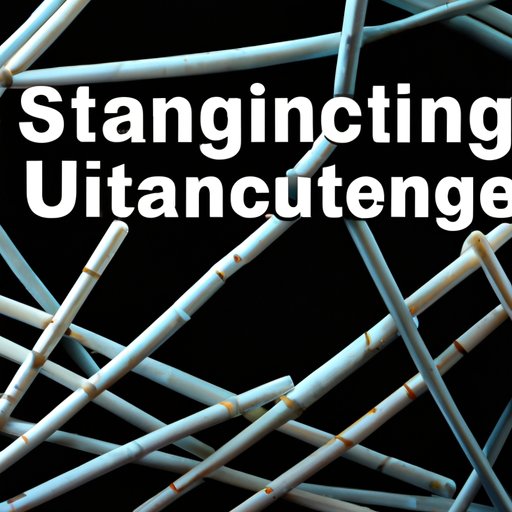
I. Introduction
Money laundering is a sophisticated criminal activity that involves concealing the true origin of illicit funds to make them appear legal. One of the ways this is achieved is through structuring, a process used to move large amounts of cash into smaller, seemingly legitimate transactions to evade detection. Understanding structuring is critical for businesses and law enforcement as it helps uncover illicit activities and protect against potential damage. This article explores what structuring entails, its importance, and methods for businesses and law enforcement to combat it.
II. The Importance of Structuring in Money Laundering Cases: A Comprehensive Guide
Structuring is an essential component of money laundering and plays a critical role in executing successful illegal transactions. It involves moving large sums of cash in a way that ensures it goes undetected. The legal definition of structuring is knowingly and intentionally conducting one or more transactions within 24 hours in a manner designed to evade currency transaction report (CTR) requirements. Penalties for structuring can range from fines to imprisonment, and businesses can face civil and criminal penalties for failing to report suspicious activity to authorities.
III. How Structuring is Used to Hide Illicit Activity in Money Laundering
Structuring is typically used to hide the sources of illicit funds and obscure their illegal origins. Criminals may structure transactions to finance their illegal activities without attracting attention from law enforcement. Recent case studies show that structuring is often used in smuggling operations, drug trafficking, and terrorism financing. It enables institutions and individuals to transport large amounts of cash while avoiding bank reporting requirements. Because cash transactions are difficult to trace, structuring remains a preferred method for many criminals.
IV. Understanding Structuring: The Method Behind Money Laundering Madness
Structuring is characterized by a range of methods that are used to move large sums of cash undetected. These methods include breaking down funds into smaller amounts, depositing cash in banks and financial institutions, and using multiple accounts or intermediaries to complete transactions. Structuring also involves structuring funds to move across borders through money exchange houses. Understanding these techniques is important in combating money laundering as it ensures authorities can detect and stop activities that may hide the sources of illicit funds.
V. Breaking Down Structuring: A Closer Look at FinCEN’s Anti-Money Laundering Regulations
FinCEN, the Financial Crimes Enforcement Network, is a regulatory body that enforces anti-money laundering regulations in the US. FinCEN has imposed requirements on financial institutions to monitor transactions, maintain a risk-based Compliance Program, and report suspicious activities. Institutions must maintain records of cash transactions exceeding $10,000 and report suspicious activities to FinCEN. Many companies use tactics such as splitting transactions across accounts and underreporting transactions to avoid these requirements. Institutions that fail to comply with FinCEN regulations face severe penalties and can be penalized by other regulatory bodies.
VI. The Role of Structuring in Money Laundering: An Analysis of Recent Cases and Trends
Recent cases in the US and Europe provide insight into how structuring techniques are evolving. The use of cryptocurrency is increasing steadily as criminals seek to move funds across borders with more anonymity. Structuring also enables cybercriminals to launder money through virtual assets. Drug trafficking networks and indigenous criminal groups continue to use structured cash transactions to launder illicit funds. Trends show an escalation in the use of electronic transfers and a decrease in the use of cash with new products being introduced regularly, making it even harder for authorities to trace illicit transactions.
VII. Why Structuring is More Than Just a Financial Crime: Implications for Businesses and Law Enforcement
Structuring activities not only threaten the integrity of the financial system but have broader implications for society. Illicitly laundered funds can be used to finance terrorist activities, corrupt government officials, or support criminal organizations. It is important for businesses and law enforcement to take proactive steps to combat this trend. Financial institutions need to develop preventive measures to identify and report suspicious activities, and law enforcement agencies need to follow the FinCEN regulations strictly to bring those involved in such activities to justice.
VIII. Conclusion
Money laundering is a sophisticated criminal enterprise, and understanding the role of structuring is essential in combatting illicit activities. Businesses and law enforcement agencies must be aware of the methods of structuring and the regulations surrounding it to prevent criminal activities. The use of multiple intermediaries, electronic transfers, and cryptocurrency makes the work of law enforcement more challenging. Breaking down these barriers is essential to stopping criminal organizations from thriving. With better regulation and greater collaboration, businesses and law enforcement agencies can work together to combat structuring activities and eliminate the threat posed by criminal activities.
Readers are encouraged to take proactive measures to protect their businesses and themselves from structuring activities. Any suspicious activities should be reported to the relevant authorities to assist in combating criminal activities.





